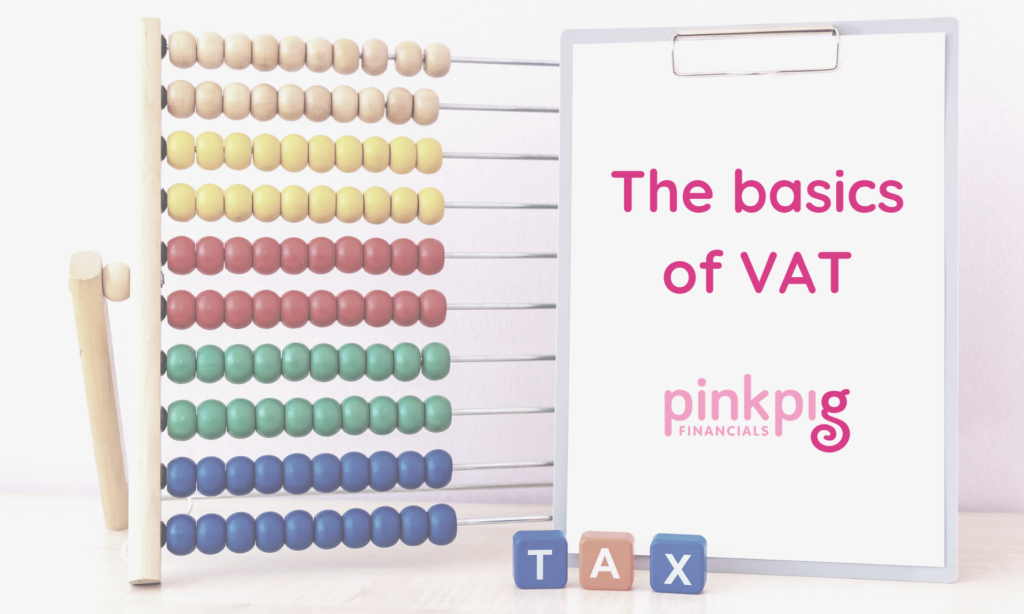What is VAT?
VAT is a sales tax charged on the sale of goods or services. The current standard rate of VAT is 20% (there are a few other rates too, but we’ll get to those later!). If you are VAT registered you will need to add VAT to your sale price.
Check out our video and the details below to learn more about VAT, how it works and what you need to do.
When do I need to register for VAT?
If your turnover (sales amount) goes over the threshold (currently £85,000) in a rolling 12-month period you’ll need to register for VAT – not in a tax year/calendar year/financial year! This is why it is good to have up to date figures and if you’re nearing this threshold, you’ll need to check each month to see where you stand.
If you expect to go over the threshold in a single 30-day period, you also need to register.
You can also register for VAT voluntarily when you are below the threshold. This could help with cash flow or make you more profitable if you purchase a lot of Vatable items. It can also help you look more professional – less of a one-man band. Some larger companies will only work with VAT registered businesses too.
Remember you can only claim back VAT paid to suppliers if you are VAT registered, and you can only charge VAT if you are registered!
How does VAT work?
Here is a basic example of how you’d account for things and VAT works – I’ve included pre-VAT registration and post VAT registration examples so you can see the difference.
Pre VAT:
Sale price £100
Purchase price £12 (inc VAT from your supplier)
Profit (£100 sale price less £12 purchase price) = £88 which you will pay corporation tax on.
You don’t charge your customer VAT, and you can’t claim VAT that you paid to your supplier. The whole cost from your supplier is put through your accounts as the purchase price.
Post VAT:
Sale Price £100 plus 20% VAT = £120
Purchase Price £10 plus 20% VAT =£12 as before.
On quarterly VAT return you pay the £20 sales VAT (output VAT), but also reclaim the £2 purchase VAT (input VAT), meaning you actually pay HMRC £18 (the difference)
Your profit is then £100 (sales price before VAT) less £10 (Purchase price before VAT) = £90 profit which you will pay corporation tax on.
What other rates of VAT are there?
As we mentioned earlier, 20% is the standard rate of VAT. This is the rate charged on most Vatable goods and services.
There are also:
- 5% rate also referred to as the reduced rate of VAT – most common examples being residential electric and gas charges.
- 0%/zero rated – most common examples being food, medicine, water, children’s clothes, books (physical not eBooks), newspapers and new build homes
- exempt – most common examples being insurance policies and stamps
- reverse charge – this is common in telecoms and IT industries, and has also recently been introduced in the Construction Industry
If your business falls into a non-standard VAT sale rate please do speak to your accountant to get more relevant advice on what you can and can’t do with VAT as the rules can be quite complex.
Do I need a VAT receipt every time I buy something?
YES! Remember to always obtain a VAT receipt from your supplier – this will show as a minimum the VAT number for the supplier, and if the purchase is over £100 it will also show a breakdown of the VAT rate and amounts. If the purchase is under £100 suppliers do not always show the breakdown. If you’re ever unsure, just ask your supplier and they will be able to advise. If you do not obtain a VAT receipt then you cannot claim the VAT back on your VAT return. The card receipt from the card machine is not sufficient – you need the till receipt too! For more on VAT receipts check out this blog by our Caroline.
When do I need to do a VAT return?
VAT returns are submitted to HMRC covering quarterly periods – you can usually choose your quarterly stagger when you register – most businesses ensure their stagger is in line with their year end, for example:
Jan, Apr, July, Oct
Feb, May, Aug, Nov
Mar, June, Sept, Dec
You have 1 month and 1 week after the quarter end before your VAT return needs to be submitted to HMRC and any VAT due paid.
Is there more to VAT than this?
Yes, this blogs just covers the basics, for example there are various schemes available to businesses which are different ways to pay your VAT return. We have the following blogs covering more area’s of VAT as follows:
- Should I register for VAT voluntarily?
- Reverse charge VAT for the construction Industry
- What is a VAT receipt and why do I need one?
- What VAT scheme do I use?
- Why do you need an accountant to prepare and file tax returns – isn’t it just a click of a button?
Let us know if you have any other questions on hello@pinkpigfinancials.co.uk and we’ll write a blog to answer them!
(And if you’re really really bored and/or want some bedtime reading to send you off to sleep, here is the link to VAT on HMRC’s website!)
How can I get help?
At PPF we can assist with advising on what you need to do, getting you registered and set up for MTD (Making Tax Digital) and actually prepare and file your VAT returns. Find out more about our VAT Service here.

